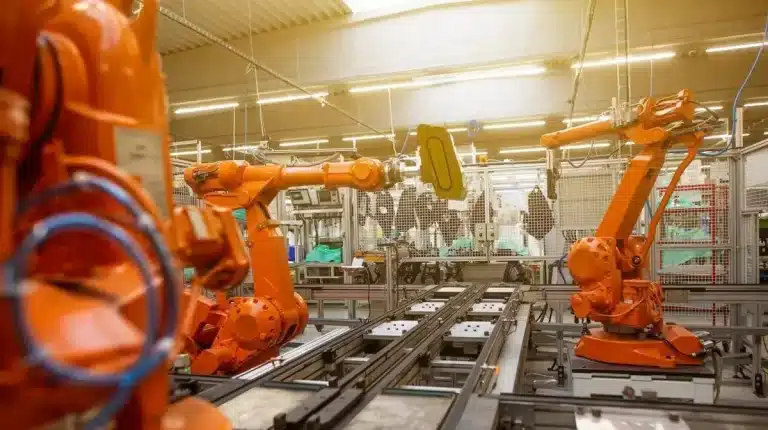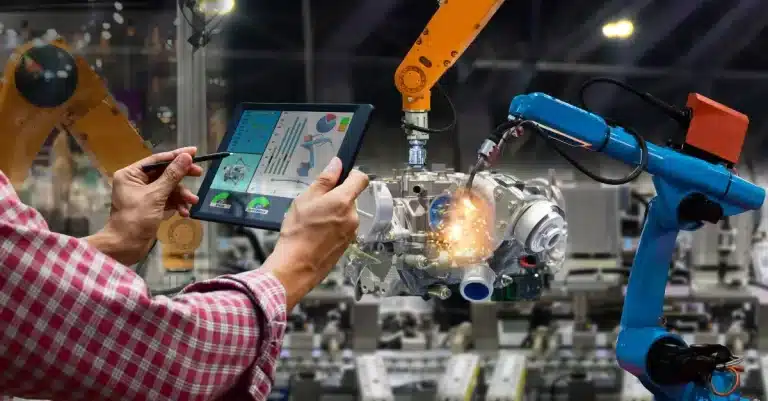Deep learning has emerged as a powerful tool in the field of artificial intelligence (AI) and has revolutionized various industries, including machine vision.
Machine vision, also known as computer vision, involves using cameras and image processing algorithms to enable machines to perceive and understand visual information.
By incorporating deep learning techniques into machine vision systems, companies are able to achieve higher accuracy, faster processing times, and improved performance in a wide range of applications.
Understanding Deep Learning
What is Deep Learning?
Deep learning is a subset of machine learning that focuses on the development and application of artificial neural networks. It involves training neural networks with vast amounts of data to learn patterns, recognize objects, and make decisions with minimal human intervention.
Unlike traditional machine learning algorithms that rely on handcrafted features, deep learning algorithms leverage multiple layers of interconnected nodes, or neurons, to automatically extract and learn features from input data.
Neural Networks and Convolutional Neural Networks
Neural networks are at the core of deep learning. These networks are composed of interconnected layers of neurons that process and transmit information. Convolutional neural networks (CNNs) are a specialized type of neural network that excel at analyzing visual data.
They mimic the visual processing capabilities of the human brain by employing multiple layers of convolutional and pooling operations to automatically extract relevant features from images.
Deep Learning in Machine Vision
Traditional Machine Vision vs Deep Learning
Traditional machine vision systems rely on rule-based algorithms and handcrafted features to detect and classify objects. While these methods have been successful in many applications, they often struggle in complex scenarios with variations in lighting, viewpoint, and object appearance.
Deep learning, on the other hand, has the ability to learn and adapt to these variations by effectively modeling and analyzing large datasets. This makes it more robust and accurate compared to traditional machine vision techniques.
Applications of Deep Learning in Machine Vision
Deep learning has found applications in numerous machine vision tasks, such as object recognition, defect classification, and image segmentation.
In object recognition, deep learning algorithms can accurately detect and classify objects in real-time, even in cluttered or occluded scenes.
Defect classification is another area where deep learning excels, as it can identify subtle defects in manufacturing processes with high precision.
Image segmentation using deep learning algorithms enables precise identification and separation of different regions within an image, which is useful in medical imaging and autonomous driving systems.
Deep Learning for Computer Vision Tasks
Deep learning has revolutionized computer vision tasks by achieving state-of-the-art performance in various domains.
Object detection, for instance, involves localizing and classifying multiple objects within an image.
Deep learning-based object detection methods, such as the popular YOLO (You Only Look Once) algorithm, have achieved remarkable accuracy and speed in real-time applications.
Pose estimation, which involves estimating the position and orientation of objects within a scene, can also benefit from deep learning techniques.
By analyzing depth and RGB data, deep learning algorithms can accurately estimate poses, enabling advancements in robotics and augmented reality technologies.

Advantages and Challenges of Deep Learning in Machine Vision
Advantages of Deep Learning
Deep learning offers several advantages over traditional machine vision techniques. One major advantage is its ability to automatically learn features from raw data, eliminating the need for manual feature extraction.
This significantly reduces the time and effort required to develop machine vision systems. Deep learning also excels at handling complex and unstructured data, allowing it to handle a wide variety of machine vision applications.
Furthermore, deep learning models can continuously optimize their performance through training on large datasets, improving accuracy and adaptability over time without the need for frequent manual adjustments.
Challenges of Deep Learning in Machine Vision
While deep learning has shown tremendous potential in machine vision, it also comes with its own set of challenges.
One significant challenge is the need for large labeled datasets for training deep learning models. Acquiring and annotating such datasets can be time-consuming and expensive.
Additionally, deep learning models require substantial computational resources for training and inference, making them computationally expensive.
Model interpretability is another challenge in deep learning, as the complexity of neural networks often makes it difficult to understand why a particular decision was made.
Deep Learning Methods and Software
Deep Learning Software
There are several deep learning software frameworks available that provide the necessary tools and libraries for developing and deploying deep learning models in machine vision applications.
Some popular deep learning software frameworks include TensorFlow, Keras, PyTorch, and Caffe.
Deep Learning Methods for Machine Vision
Deep learning methods for machine vision encompass a wide range of algorithms and techniques.
These methods include convolutional neural networks (CNNs), recurrent neural networks (RNNs), generative adversarial networks (GANs), and deep belief networks (DBNs).
Each of these methods is designed to tackle specific machine vision tasks and has been widely adopted in various industries.
Applications of Deep Learning in Computer Vision
Object Recognition and Detection
Object recognition and detection are crucial tasks in computer vision. Deep learning algorithms have achieved remarkable performance in these tasks, enabling real-time detection and classification of objects in images and videos.
Face Recognition
Face recognition is another area where deep learning has made significant advancements. Deep learning models can accurately identify and verify individuals based on facial features, enabling applications such as access control, surveillance, and personalized user experiences.
Motion Detection
Deep learning algorithms have been successful in detecting and tracking motion in videos. This is particularly useful in security systems, sports analysis, and autonomous vehicles, where real-time understanding of moving objects is critical.
Pose Estimation
Pose estimation involves determining the position and orientation of objects in 3D space. Deep learning algorithms can estimate poses accurately using depth and RGB data, allowing for applications in robotics, virtual reality, and augmented reality.
Semantic Segmentation
Semantic segmentation refers to the process of assigning meaningful labels to each pixel in an image. Deep learning algorithms excel at semantic segmentation tasks, which have numerous applications in medical imaging, autonomous driving, and remote sensing.
Deep Learning in Various Industries
Transportation
In the transportation industry, deep learning is being used to enhance driver assistance systems, autonomous vehicles, and traffic management. Deep learning algorithms can analyze real-time data from cameras and sensors to detect objects, track vehicles, and make intelligent decisions based on road conditions.
Healthcare
Deep learning has the potential to revolutionize healthcare by assisting in medical diagnosis, pathology analysis, and drug discovery. Deep learning models can analyze medical images, such as X-rays and MRI scans, to detect abnormalities and assist doctors in making accurate diagnoses.
Sports
Deep learning is increasingly being applied in sports analytics, enabling coaches and teams to gain insights from vast amounts of video data. By analyzing player movements, tracking ball trajectories, and detecting patterns, deep learning algorithms can provide valuable statistics and performance metrics to optimize training and strategy.
Manufacturing
In the manufacturing industry, deep learning is used for quality control, defect detection, and process optimization. By analyzing images and sensor data, deep learning algorithms can identify defects, classify products, and optimize production processes, leading to improved efficiency and product quality.
Retail
Deep learning has the potential to transform the retail industry by enabling personalized marketing, inventory management, and customer analytics. By analyzing customer behavior, preferences, and purchasing patterns, deep learning algorithms can provide targeted recommendations, optimize stock levels, and enhance the overall shopping experience.
Frequently Asked Questions
What is the role of deep learning in machine vision?
Deep learning plays a crucial role in machine vision by enabling the development of advanced algorithms that can automatically learn and extract meaningful information from visual data. It has revolutionized the field of computer vision by allowing machines to analyze and interpret images and videos, enabling applications such as object recognition, image classification, and even natural language processing.
How does deep learning differ from traditional machine vision?
Traditional machine vision relies on handcrafted features and algorithms to process and interpret visual data. Deep learning, on the other hand, uses neural networks, specifically, convolutional neural networks (CNNs), to automatically learn and extract features from images. This approach eliminates the need for manual feature engineering and has been proven to be more effective in handling complex vision tasks.
What are convolutional neural networks (CNNs) and how are they used in deep learning for computer vision?
Convolutional neural networks (CNNs) are a type of deep neural network designed specifically for processing and analyzing visual data. They consist of multiple layers, including convolutional layers, pooling layers, and fully connected layers. CNNs can learn hierarchical representations of visual data, making them very effective for tasks such as image classification, object detection, and segmentation.
How can deep learning be applied to computer vision applications?
Deep learning can be applied to computer vision applications by using deep learning software and frameworks that provide pre-trained models or tools for training your own models. These models can be fine-tuned for specific vision tasks, such as image classification, object detection, or segmentation. By leveraging deep learning, computer vision systems can achieve higher accuracy and better performance in a wide range of applications.
What are some examples of computer vision tasks that can benefit from deep learning?
Some examples of computer vision tasks that can benefit from deep learning include image classification, object detection, semantic segmentation, facial recognition, pose estimation, scene understanding, video analysis, and many more. Deep learning enables these tasks to be performed with higher accuracy and robustness, opening up new possibilities for automation and inspection in various industries.
How does deep learning improve the accuracy of vision applications?
Deep learning improves the accuracy of vision applications by enabling the automatic learning of features from large amounts of labeled data. Traditional machine vision algorithms rely on manually designed features that may not capture all the relevant information in the data. Deep learning models, however, can learn complex patterns and relationships directly from the data, leading to improved accuracy and performance.
What deep learning software or tools can be used for computer vision applications?
There are several deep learning software and tools available for computer vision applications. Some popular ones include TensorFlow, PyTorch, Caffe, Keras, and MXNet. These frameworks provide a wide range of functionalities for building, training, and deploying deep learning models for various vision tasks.
How can I learn more about deep learning for computer vision?
To learn more about deep learning for computer vision, you can explore online courses, tutorials, and resources dedicated to this topic. There are also books and research papers that delve into the theory and applications of deep learning in computer vision. Additionally, attending conferences and workshops on computer vision and deep learning can provide valuable insights and networking opportunities.
How is deep learning used in machine vision technologies?
Deep learning is used in machine vision technologies to enhance the capabilities of vision systems. By leveraging deep learning algorithms, machine vision systems can perform tasks such as image classification, pattern recognition, defect detection, and quality control with higher accuracy and efficiency. Deep learning-based machine vision tools can automate various inspection processes and improve overall productivity in industries such as manufacturing, robotics, and healthcare.
How can deep learning be used to determine natural language in computer vision applications?
Deep learning can be used to determine natural language in computer vision applications by combining visual information with textual data. For example, deep learning models can be trained to recognize objects in images and then associate them with corresponding text descriptions or lab
Summary
In conclusion, deep learning plays a crucial role in advancing machine vision and computer vision systems.
Its ability to automatically extract features from raw data, its adaptability to complex scenarios, and its impressive performance in various tasks make it a powerful tool in industries ranging from transportation to healthcare to retail.
As research and development in deep learning continue to progress, we can expect further advancements in machine vision applications and the widespread adoption of deep learning technologies.

